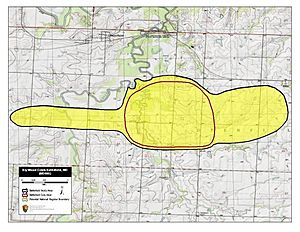Battle of Dry Wood Creek facts for kids
Quick facts for kids Battle of Dry Wood Creek |
|||||||
|---|---|---|---|---|---|---|---|
| Part of the Trans-Mississippi Theater of the American Civil War |
|||||||
| Lua error in Module:Location_map at line 420: attempt to index field 'wikibase' (a nil value). | |||||||
|
|||||||
| Belligerents | |||||||
| Commanders and leaders | |||||||
| Units involved | |||||||
| Missouri State Guard | Lane's Kansas Brigade | ||||||
| Strength | |||||||
| 6,000 or 10,000 | 600 or 1,200 | ||||||
| Casualties and losses | |||||||
| 25 total * 2 killed * 23 wounded |
11 total * 5 killed * 6 wounded |
||||||
The Battle of Dry Wood Creek, also known as the Battle of the Mules, was a fight during the American Civil War. It happened on September 2, 1861, in Vernon County, Missouri.
After winning the Battle of Wilson's Creek, Confederate General Sterling Price and his Missouri State Guard moved north. Union General James H. Lane led troops from Fort Scott, Kansas. He tried to stop Price's army. Lane set up a surprise attack along Dry Wood Creek.
Price's Missouri State Guard had many more soldiers than Lane's Kansas troops. After about two hours of fighting, Lane's men had to retreat. They left behind their supplies and many mules. Price continued his march north. He later won another battle at the siege of Lexington.
Why the Battle Happened
When the American Civil War started in 1861, Missouri was a "border state." This meant it was a state where slavery was legal, but it did not leave the United States. Missouri's governor, Claiborne F. Jackson, supported the Confederate States of America. He tried to use the state militia to help the Confederates.
Union General Nathaniel Lyon quickly stopped Jackson's militia in St. Louis. This event was called the Camp Jackson affair. After this, Governor Jackson formed a new group called the Missouri State Guard. He put Sterling Price in charge.
General Lyon fought Price's new force at the Battle of Boonville. Price's Missouri State Guard then moved to southwestern Missouri. There, they joined with Confederate forces led by General Benjamin McCulloch.
On August 10, Lyon attacked Price and McCulloch near Wilsons Creek. Lyon's Union forces were greatly outnumbered. In the Battle of Wilson's Creek, the Union army lost, and General Lyon was killed.
After Wilson's Creek, the Union army went back to Rolla, Missouri. General McCulloch's forces went to Arkansas. Price's Missouri State Guard took control of Springfield.
Union General John C. Fremont took charge of Union forces in Missouri. General James H. Lane commanded several Kansas regiments at Fort Scott. Meanwhile, General Price began moving north with a large army. Fremont then declared martial law in Missouri. This meant the military took control of the state.
The Battle of Dry Wood Creek
General Lane sent his troops to stop Price's army. Lane had between 600 and 1,200 soldiers. He set up a surprise attack along Dry Wood Creek in Vernon County, Missouri. The area was heavily wooded, which helped Lane hide his men.
The first parts of Price's Missouri State Guard marched right into Lane's trap. But Price quickly brought up more soldiers. The Missourians had many more men, which was key to their victory.
Lane's skirmishers (soldiers who fight in small, spread-out groups) were pushed back. The main Union force used the woods for cover. They held off Price's army for about two hours. However, Price's men eventually overwhelmed the Kansans. Lane's troops had to retreat back to Fort Scott.
During their retreat, Lane's soldiers left behind their supplies and many mules. Price said that his soldiers' experience from Wilson's Creek helped them win. Because of the captured mules, the battle is sometimes called the "Battle of the Mules." Winning at Dry Wood Creek allowed Price to keep moving his army north. His army then headed to Johnson County, Missouri.
After the battle, General Lane reported that his forces lost five men killed and six wounded. General Price reported that his army lost two men killed and twenty-three wounded. Most of Price's wounded soldiers had minor injuries.
What Happened Next
After reaching Johnson County, Price's army continued to Lexington, Missouri. A Union army group was defending the town. Price's men surrounded them, starting the siege of Lexington.
The Missouri State Guard defeated the Union soldiers. At one point, they used large bales of hemp as shields while attacking uphill. After the Union soldiers surrendered, Price's army stayed in Lexington for two weeks. Then, Price ordered his unit to return south.
Today, there are markers near Deerfield, Missouri, to remember the battle site. A museum in nearby Nevada, Missouri, tells the story of the Battle of Dry Wood Creek and the Civil War in Missouri.


